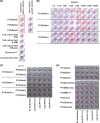Development of a particle agglutination method with soluble virus receptor for identification of poliovirus
- PMID: 20519462
- PMCID: PMC2916603
- DOI: 10.1128/JCM.00207-10
Development of a particle agglutination method with soluble virus receptor for identification of poliovirus
Abstract
In the Global Polio Eradication Initiative, laboratory diagnosis plays a critical role by isolating and identifying poliovirus (PV) from the stool samples of patients with acute flaccid paralysis (AFP). In this study, we developed a particle agglutination (PA) method with a soluble human PV receptor (hPVR) in the form of an immunoadhesin (PVR-IgG2a) for the simple and rapid identification of PV. Sensitized gelatin particles with PVR-IgG2a showed specific agglutination with the culture fluid of PV-infected cells within 2 h of reaction in a one-step procedure. Detection limits for type 1, 2, and 3 PV(Sabin) strains were 1.5 x 10(6) 50% cell culture infectious doses (CCID(50)), 5.3 x 10(5) CCID(50), and 9.1 x 10(5) CCID(50), respectively. Wild-type PVs and PV isolates from acute flaccid paralysis cases examined were identified correctly with this PA method, except for some samples with a mixture of different serotypes of PVs, where a minor population of PV failed to be detected. These results suggest that this PA method is useful for the simple and rapid identification of PV, although the sensitivity was not high enough to detect a minor population of PV (<1/10 of the major population) among mixed PVs.
Figures


Similar articles
-
Culture-Independent Detection of Poliovirus in Stool Samples by Direct RNA Extraction.Microbiol Spectr. 2021 Dec 22;9(3):e0066821. doi: 10.1128/Spectrum.00668-21. Epub 2021 Nov 10. Microbiol Spectr. 2021. PMID: 34756088 Free PMC article.
-
Particle agglutination method for poliovirus identification.J Vis Exp. 2011 Apr 20;(50):2824. doi: 10.3791/2824. J Vis Exp. 2011. PMID: 21540819 Free PMC article.
-
Development of a reverse transcription-loop-mediated isothermal amplification (RT-LAMP) system for a highly sensitive detection of enterovirus in the stool samples of acute flaccid paralysis cases.BMC Infect Dis. 2009 Dec 16;9:208. doi: 10.1186/1471-2334-9-208. BMC Infect Dis. 2009. PMID: 20015403 Free PMC article.
-
Role of environmental poliovirus surveillance in global polio eradication and beyond.Epidemiol Infect. 2012 Jan;140(1):1-13. doi: 10.1017/S095026881000316X. Epub 2011 Aug 18. Epidemiol Infect. 2012. PMID: 21849095 Review.
-
Eradication of wild poliovirus from the Americas: acute flaccid paralysis surveillance, 1988-1995.J Infect Dis. 1997 Feb;175 Suppl 1:S37-42. doi: 10.1093/infdis/175.supplement_1.s37. J Infect Dis. 1997. PMID: 9203690 Review.
Cited by
-
Culture-Independent Detection of Poliovirus in Stool Samples by Direct RNA Extraction.Microbiol Spectr. 2021 Dec 22;9(3):e0066821. doi: 10.1128/Spectrum.00668-21. Epub 2021 Nov 10. Microbiol Spectr. 2021. PMID: 34756088 Free PMC article.
-
Direct detection of polioviruses using a recombinant poliovirus receptor.PLoS One. 2021 Nov 2;16(11):e0259099. doi: 10.1371/journal.pone.0259099. eCollection 2021. PLoS One. 2021. PMID: 34727100 Free PMC article.
-
Development of poliovirus extraction method from stool extracts by using magnetic nanoparticles sensitized with soluble poliovirus receptor.J Clin Microbiol. 2013 Aug;51(8):2717-20. doi: 10.1128/JCM.00499-13. Epub 2013 May 22. J Clin Microbiol. 2013. PMID: 23698530 Free PMC article.
-
Particle agglutination method for poliovirus identification.J Vis Exp. 2011 Apr 20;(50):2824. doi: 10.3791/2824. J Vis Exp. 2011. PMID: 21540819 Free PMC article.
References
-
- Arita, M., S. Ohka, Y. Sasaki, and A. Nomoto. 1999. Multiple pathways for establishment of poliovirus infection. Virus Res. 62:97-105. - PubMed
-
- Bibb, J. A., G. Witherell, G. Bernhardt, and E. Wimmer. 1994. Interaction of poliovirus with its cell surface binding site. Virology 201:107-115. - PubMed
-
- Escobar-Gutierrez, A., M. E. Amezcua, S. Pasten, F. Pallares, J. V. Cazares, R. M. Pulido, O. Flores, E. Castro, and O. Rodriguez. 1993. Comparative assessment of the leprosy antibody absorption test, Mycobacterium leprae extract enzyme-linked immunosorbent assay, and gelatin particle agglutination test for serodiagnosis of lepromatous leprosy. J. Clin. Microbiol. 31:1329-1333. - PMC - PubMed
Publication types
MeSH terms
Substances
LinkOut - more resources
Full Text Sources
Medical
Research Materials

